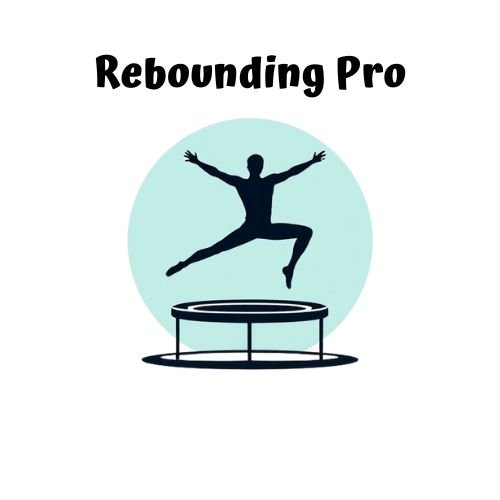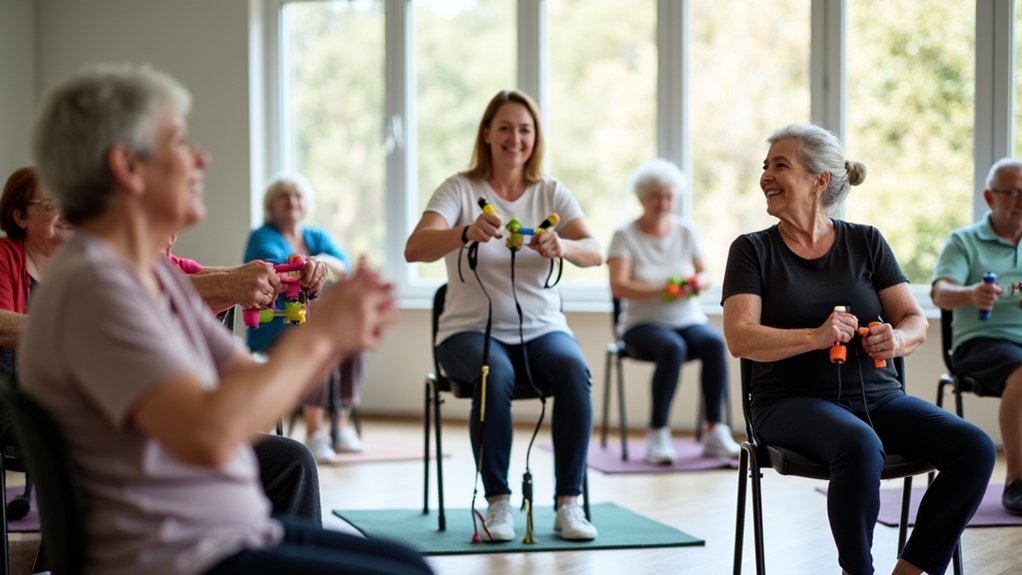Mini core workouts can effectively sculpt your abs in just minutes a day. Research shows that short, high-intensity sessions engage deep abdominal muscles through rapid eccentric-concentric cycles. Rebounding on a mini-trampoline particularly targets your core as your body stabilizes against vertical forces. Combine these bouncing movements with proper pelvic positioning to maximize engagement. You’ll see improvements in balance, posture, and abdominal definition within weeks—without spending hours at the gym. The secret lies in understanding the science of efficient core activation.
The Science Behind Mini Core Workouts

While many people assume effective core training requires lengthy gym sessions, research consistently proves that mini-workouts can deliver remarkable results. Studies show that just 30 minutes of high-intensity exercise weekly can greatly reduce cardiovascular risks while improving your balance and stability.
Your core acts as the foundation for all movement, and strengthening these muscles improves everything from athletic performance to daily function. Research demonstrates that an 8-week core training program enhances running economy and balance, while also boosting vertical and horizontal jumping capabilities. Core muscle strengthening is crucial for all age groups, particularly for older adults who engage in less strength training compared to younger individuals.
You’ll also experience better postural control and reduced injury risk. The physiological benefits extend beyond appearance—core endurance supports better movement efficiency, stabilizes your spine during activity, and can effectively alleviate back pain without requiring hours of gym time.
5-Minute Rebounding Exercises for Abdominal Definition
Rebounding exercises offer a revitalizing alternative to traditional core workouts that can be completed in minutes rather than hours.
This low-impact exercise on a mini-trampoline engages multiple muscle groups with each bounce while strengthening your deep core stabilizers.
Maximize your rebounding routine by activating your core—pull your navel toward your spine and lower your tailbone during each bounce.
Try incorporating single-leg movements and trampoline sprints to enhance stability and abdominal definition.
Alternating between high and low-intensity bounces creates an efficient workout that combines cardio benefits with targeted core engagement.
For safety, use a sturdy mini-trampoline, wear non-slip shoes, and guarantee adequate space around your equipment.
Start with gentle bounces as a warm-up before progressing to more dynamic movements.
Regular rebounding sessions can significantly improve your bone density and pelvic floor health, making it an excellent exercise choice for those concerned about osteoporosis.
How Bouncing Movements Target Deep Core Muscles

Beneath the surface of each bounce lies a symphony of core muscle activation that traditional exercises often fail to engage.
Beneath the vibrant rhythm of bouncing, your core awakens to engage in ways standard workouts simply cannot match.
When you rebound, your body generates vertical forces that demand immediate stabilization from your transverse abdominis and multifidi muscles.
Your core works through rapid eccentric-concentric cycles during bouncing, enhancing neuromuscular activation.
Each landing phase intensifies transverse abdominis engagement while simultaneously activating your pelvic floor to regulate intra-abdominal pressure.
What makes bouncing uniquely effective is its three-dimensional loading pattern.
As you navigate unpredictable bounce vectors, your core must continuously adapt, utilizing elastic energy through fascial tissue connections.
This proprioceptive challenge improves your core awareness while the low-impact nature allows for higher repetition volumes without joint stress. For optimal core engagement, maintain a proper pelvic tilt position throughout all bouncing movements.
Progressive Intensity Techniques for Belly Fat Reduction
Despite persistent myths about spot reduction, effectively targeting belly fat requires a strategic approach that progressively increases workout intensity. You’ll need to combine HIIT workouts with resistance training to maximize your metabolic rate long after exercising. Stay consistent with your water intake, as proper hydration helps boost metabolism and can reduce hunger between meals.
| Technique | Beginner | Advanced |
|---|---|---|
| HIIT | 20-second intervals with 40-second rest | 40-second intervals with 20-second rest |
| Core Work | Standard planks (30 seconds) | Russian twists with weights (3 sets) |
| Cardio | Walking (30 minutes) | Jogging intervals (30 minutes) |
Start with isometric exercises like planks, then progress to dynamic movements such as mountain climbers. Don’t forget that stress management techniques like progressive muscle relaxation complement your physical efforts. Pair this regimen with a protein-rich diet and reduced alcohol intake for ideal results.
Stability-Enhancing Rebounding Sequences for Spinal Health

The gentle bouncing motion of mini-trampoline exercises creates a powerful foundation for spinal health that traditional workouts simply can’t match. Each bounce activates your deep spinal stabilizers, transverse abdominis, and multifidus muscles through continuous micro-adjustments.
You’ll experience multiple benefits beyond mere strengthening. The rhythmic vertical loading increases bone density while reducing compression, actually helping your intervertebral discs receive better nutrition through dynamic hydration cycles. Starting with gentle bouncing can help ease into the exercise regimen, especially for those with existing back pain.
Your proprioception and balance improve considerably, reducing fall risk and enhancing coordination.
What’s remarkable is how rebounding outperforms traditional resistance training by 25% for muscle improvement while flushing inflammatory markers from your spine.
Regular practice could potentially extend your lifespan by 3.4 years while preventing age-related spinal curvature and sarcopenia-related instability.
Measuring Your Core Strength Progress From Short Workouts
You’ll notice improved neural recruitment when your body responds faster to core engagement cues during your mini-workouts.
Your balance improvement rate becomes evident as you maintain stability longer in challenging positions without compensatory movements.
The quality of your movements—showing less wobbling, smoother shifts, and more controlled breathing—offers tangible proof that your core strength is building even from short exercise sessions.
Regular assessment of your core strength using tests like the plank, bird dog, or leg lower will help you avoid developing muscle imbalances that could lead to injuries over time.
Track Neural Recruitment Patterns
While mini-workouts may seem brief, understanding how your brain communicates with your core muscles reveals their true effectiveness. Your body builds neural pathways with each exercise, enhancing movement efficiency even during short sessions.
Pay attention to how your muscles respond during different exercises. You’ll notice improved coordination between local stabilizers (transversus abdominis) and global mobilizers (rectus abdominis) as your neural patterns develop. Consider measuring both your maximal strength and endurance to get a comprehensive view of your core capabilities, as research shows these are distinct components that should be assessed separately.
| Neural Adaptation | What You’ll Feel | Why It Matters |
|---|---|---|
| Feed-forward activation | Muscles engage before movement | Prevents injury |
| Improved stability | Less wobbling during planks | Better posture |
| Muscle memory | Automatic engagement | Everyday protection |
| Task-specific recruitment | Right muscles for right moves | Efficient power |
| Bilateral coordination | Balanced strength | Reduced asymmetry |
Track these neural improvements alongside traditional metrics like hold times for a complete picture of your progress.
Measure Balance Improvement Rate
Beyond neural patterns, concrete measurements tell the story of your mini-workout progress. By tracking balance improvements systematically, you’ll quantify your core’s stabilization abilities over time.
Start measuring with these practical methods:
- Weekly plank progression – Aim for 5-10 second improvements in hold times, noting when hip alignment stabilizes during longer durations.
- Balance-to-strength ratio – Record how single-leg stability correlates with your isometric core strength values (measured in Newtons).
- Asymmetry reduction – Track the decreasing difference between left/right stability during rotational tests (aim for less than 10% variance).
- Functional carryover – Measure how improved balance translates to enhanced agility test times or medicine ball throw distances.
Don’t wait for monthly assessments—incorporate biweekly balance tests to catch improvements your mirror might miss. Consider using the full core stability test designed by Brian Mackenzie as a comprehensive assessment of your progress over several weeks of training.
Monitor Movement Quality Gains
The quality of your movement—not just the quantity of repetitions—reveals the true effectiveness of mini-core workouts. To monitor your progress accurately, you’ll need both structural and functional assessments.
| Assessment Method | What It Measures | When To Use |
|---|---|---|
| Plank Test | Core stability/endurance | Weekly tracking |
| Medicine Ball Throw | Explosive power | Monthly benchmarking |
| T-Tests | Dynamic stability | Every 2-3 weeks |
| Double Leg Lowering | Core control | Bi-weekly checks |
| Movement Analysis | Form quality | During each workout |
Track your results systematically to identify improvements in movement quality that might not be immediately visible. While dynamometers provide precise measurements in clinical settings, simple performance tests like the plank or vertical jump can effectively gauge your progress at home. Remember, enhanced movement quality ultimately translates to better coordination, reduced injury risk, and improved athletic performance.
Frequently Asked Questions
Can Mini Core Workouts Help With Diastasis Recti After Pregnancy?
Yes, mini core workouts can help heal your diastasis recti after pregnancy. You’ll see best results when you focus on deep core stability exercises that specifically target your transverse abdominis and include pelvic floor training.
How Do Rebounding Exercises Impact Those With Herniated Discs?
If you have a herniated disc, avoid high-rebound techniques entirely. You’ll need gentle, low-amplitude bouncing with handrail support. Seated rebounding offers benefits with less lumbar strain. Always stop if you feel pain.
Are Mini Workouts Effective for Seniors With Balance Issues?
Yes, mini workouts are highly effective for your balance issues. You’ll see improvements with just 31-45 minute sessions three times weekly. They’re adaptable to your ability level and can include seated variations for safety.
Should I Combine Supplements With Mini-Workouts for Faster Results?
Supplements like caffeine or L-citrulline may enhance your mini-workout performance, but avoid antioxidants (vitamins C/E) as they can impair adaptations. Start with core training alone before adding supplements, and test single doses first for tolerance.
Can Rebounding Exercises Replace Traditional Planks for Core Strength?
Rebounding can complement but not fully replace planks. You’ll get dynamic core engagement and cardiovascular benefits from rebounding, but you’ll miss the specific muscle isolation and stability development that planks uniquely provide.
In Summary
You’ve learned how mini rebounding sessions create impressive core strength through quick, targeted movements. Don’t underestimate these short workouts—they’re engaging your deep abdominal muscles and improving spinal stability with every bounce. As you progress through intensity levels, you’ll notice tangible improvements in your core definition and strength. Keep measuring your results, and you’ll see that these efficient exercises fit perfectly into your busy lifestyle while delivering remarkable benefits.





Leave a Reply